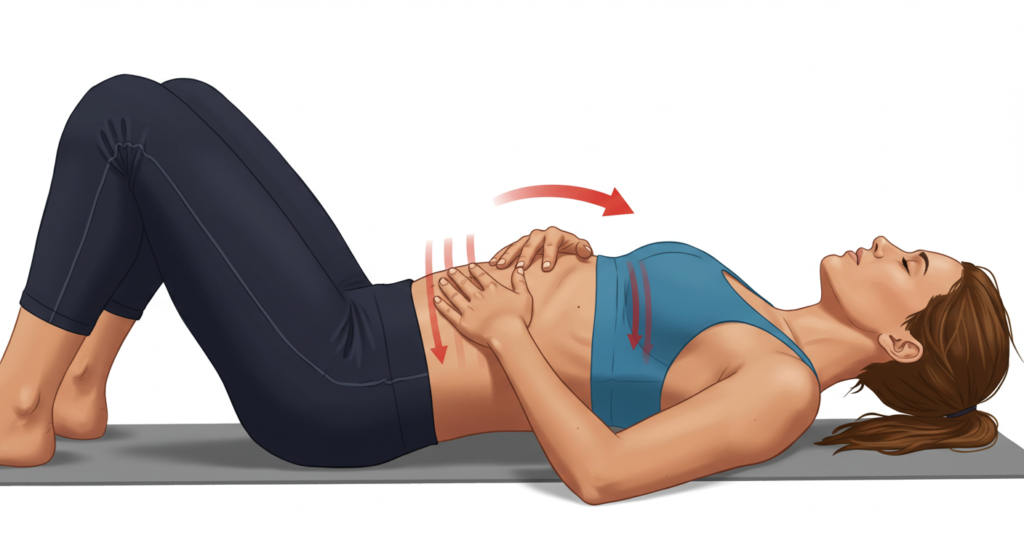That post-workout muscle ache… we’ve all been there!
You know, that delightful (not!) sensation that turns everyday movements into a painful reminder of yesterday’s sweat session.
Studies show that up to 80% of regular exercisers experience Delayed Onset Muscle Soreness (DOMS), that sneaky gremlin that can sideline your training and crush your motivation.

While ice baths, massage guns, and endless stretching are common go-to’s, what if I told you there’s a surprisingly powerful – and completely free – tool you can use to beat DOMS and bounce back faster?
The answer lies in your breath.
Specific breathing techniques to reduce muscle soreness aren’t just about relaxation (although that’s a welcome side effect!).
They’re a science-backed way to target the root causes of DOMS, reduce inflammation, improve blood flow, and modulate pain perception.
In this guide, we’ll unlock the secrets of breathing for DOMS relief, providing you with a step-by-step protocol to crush that post-workout pain and get back to training at your peak.
Get ready to breathe your way to faster healing and a DOMS-free life!
The Science of Breathing for DOMS Relief – How It Works
Think you know what causes DOMS?
You might be surprised! Before we dive into the breathing techniques themselves, let’s debunk some myths and uncover the real science behind muscle soreness.
Myth Busting – It’s NOT Just Lactic Acid!
For years, lactic acid was blamed as the primary culprit behind DOMS.
While lactic acid does contribute to muscle fatigue during exercise, it’s cleared from your system relatively quickly.
The real story behind DOMS is far more complex.
The True Culprits – Muscle Damage, Inflammation, and Cytokines

DOMS is primarily caused by microscopic damage to muscle fibers during intense or unaccustomed exercise, particularly eccentric contractions (like lowering a weight).
This damage triggers an inflammatory response, which is your body’s natural attempt to repair the damaged tissue. However, this inflammation can also cause pain, swelling, and stiffness.
A key player in this inflammatory process is cytokines.
These are small proteins that act as messengers, signaling immune cells to come to the site of injury.
While cytokines are essential for healing, an overproduction of certain cytokines can contribute to excessive inflammation and pain.”
How Breathing Techniques Come to the Rescue

So, how can breathing techniques possibly address these complex physiological processes?
Here’s the science:
Reducing Inflammation: Specific breathing patterns, especially diaphragmatic breathing, can help regulate the production of cytokines, preventing them from spiraling out of control. By activating the parasympathetic nervous system, deep breathing helps to shift your body into a state of relaxation, which can dampen the inflammatory response.
Improving Microcirculation and Nutrient Delivery: Deep breathing acts like an internal pump, improving blood flow to your muscles. This increased microcirculation delivers vital nutrients and oxygen to the damaged tissues, accelerating the repair process and helping to flush out waste products.
Activating the Parasympathetic Nervous System: As mentioned earlier, deep breathing activates your parasympathetic nervous system (PNS), shifting your body out of ‘fight or flight’ mode and into ‘rest and repair’ mode. This activation reduces stress hormones like cortisol, which can further exacerbate inflammation and hinder recovery.
Modulating Pain Perception: Breathing techniques can also influence your perception of pain through the ‘gate control theory of pain.’ This theory suggests that the nervous system can only process a limited amount of sensory information at once. By focusing on your breath and practicing mindful breathing, you can effectively ‘close the gate’ on pain signals, reducing the intensity of the discomfort you experience.
Powerhouse Breathing Techniques to Crush DOMS
Now that you understand the science, let’s get practical!
Here are 5 powerhouse breathing techniques you can use to conquer DOMS and reclaim your workouts:
Diaphragmatic Breathing (Belly Breathing)

- Description: This is the foundation of deep breathing. It promotes relaxation, reduces inflammation, and improves oxygen flow, all crucial for DOMS relief.
- How it Targets DOMS: Diaphragmatic breathing activates the parasympathetic nervous system, which helps to dampen the inflammatory response and reduce muscle tension.
- Steps:
- Find a comfortable position: Lie on your back with your knees bent, or sit comfortably.
- Place your hands: One hand on your chest, the other on your belly.
- Inhale deeply: Slowly inhale through your nose, focusing on expanding your belly. Your chest should remain relatively still.
- Exhale slowly: Exhale gently through your mouth, allowing your belly to fall.
- Repeat: Continue for 5-10 minutes, focusing on the rise and fall of your belly.
- Variations:
- Seated Diaphragmatic Breathing: Practice this technique anywhere, anytime.
- Lying Down Diaphragmatic Breathing: Easier to focus on belly breathing.
- Progressive Muscle Relaxation with Diaphragmatic Breathing: Combine diaphragmatic breathing with tensing and relaxing different muscle groups to further reduce muscle tension.
- Contraindications/Precautions: Generally safe, but consult your doctor if you have any respiratory conditions like asthma or COPD.
Box Breathing

- Description: This technique promotes relaxation, improves focus, and calms down the nervous system, helping to reduce pain perception.
- How it Targets DOMS: Box breathing activates the parasympathetic nervous system, which can help to modulate pain signals and reduce muscle tension.
- Steps:
- Find a comfortable position: Sit straight with your feet on the ground.
- Exhale completely: Empty your lungs completely.
- Inhale slowly: Inhale through the nose as you count to 4 slowly.
- Hold the breath: Count slowly to 4.
- Exhale slowly: Exhale fully through the mouth as you count slowly to 4.
- Hold the breath: Maintain the state as you count to 4.
- Repeat: 5-10 minutes.
- Contraindications/Precautions: Generally safe, but avoid holding your breath for extended periods if you have any cardiovascular issues.
Paced Breathing
- Description: Paced breathing is an exercise that encourages conscious control over the rate and depth of breathing. The intention of paced breathing is to reduce an individual’s breathing rate, increase tidal volume (the amount of air that moves in and out of the lungs with each breath), or both.
- How it Targets DOMS: improve cardiovascular and respiratory function.
- Steps:
- Keep the shoulders relaxed
- Inhale from your diaphragm
- Use your hand or tracker for a rhythmic breath.
- Exhale gently
- Contraindications/Precautions: There are no known contraindications or precautions
Progressive Muscle Relaxation with Breathing
- Description: Progressive muscle relaxation (PMR) is a relaxation technique that involves tensing and releasing different muscle groups in the body. PMR is used to reduce anxiety and muscle tension. In this situation you are flowing with your breathing.
- How it Targets DOMS: PMR helps improve blood flow that will promote faster healing to the affected body part. The nervous system is in rest mode for the body to relax with the assistance of the breathing patterns and muscle.
- Steps:
- Inhale and tense a muscle.
- Hold for 10 seconds.
- Exhale and hold for 20 seconds.
- Repeat.
- Contraindications/Precautions: Avoid doing the work if you are lightheaded or if you are on medication. Always seek the professional from a physician.
Vagus Nerve Stimulation Breathing
- Description: The vagus nerve is the longest cranial nerve in the body and connects your brain to many important organs, including the gut (intestines, stomach), heart and lungs. It is a key part of the parasympathetic “rest and digest” branch of the autonomic nervous system.
- How it Targets DOMS: Vagus nerve activation assist improve the whole recovery, promote wellness, reduce inflammation. The best combination.
- Steps:
- Lion’s Breath: Inhale deeply through your nose and stick your tongue as you exhale.
- Humming: The hum can stimulate and have your nervous system more relaxed.
- Cold Showers: To help connect with the moment.
- Meditation: To bring the body in balance.
- Contraindications/Precautions: if you have serious discomforts, discontinue right away and seek healthcare physician.
The DOMS-Busting Breathing Protocol – Your Action Plan
Ready to put it all together?
This DOMS-busting breathing protocol will help you proactively combat muscle soreness and get back to training faster.
Remember to listen to your body and adjust the protocol as needed.
- Key Principles:
- Consistency is Key: The more consistently you follow this protocol, the better your results will be.
- Listen to Your Body: Pay attention to how your body feels and adjust the techniques and timing accordingly.
- Combine with Other Strategies: Breathing techniques work best when combined with other DOMS-fighting strategies (active recovery, nutrition, sleep, etc.).
Protocol Overview Table
| Phase | Timing | Technique | Duration | Focus | Modifications |
| Pre-Workout (Prevention) | 5-10 minutes before | Diaphragmatic Breathing | 5-10 minutes | Prepare body, promote oxygen flow, set intention | Beginner: 5 minutes, Intermediate: 7 minutes, Advanced: 10 minutes |
| Post-Workout (Immediate) | Immediately after | Box Breathing | 5-10 minutes | Calm nervous system, reduce stress, initiate recovery | Light Workout: 5 minutes, Moderate Workout: 7 minutes, Intense Workout: 10 minutes |
| Recovery Days (DOMS Relief) | 2-3 times throughout day | Progressive Muscle Relaxation | 10-15 minutes | Reduce muscle tension, improve blood flow, modulate pain perception | Focus on sore muscle groups, adjust tension levels to comfort |
Detailed Protocol Instructions
- Pre-Workout (Prevention):
- Timing: 5-10 minutes before your workout.
- Technique: Diaphragmatic Breathing
- Instructions: Follow the steps outlined in Section III (Powerhouse Breathing Techniques to Crush DOMS). Focus on slow, deep breaths, expanding your belly with each inhale.
- Purpose: To prepare your body for exercise, promote oxygen flow to your muscles, and set a positive intention for your workout.
- Modifications:
- Beginner: Start with 5 minutes and gradually increase the duration as you become more comfortable.
- Intermediate: Practice for 7 minutes, focusing on maintaining a steady and consistent breath.
- Advanced: Practice for 10 minutes, incorporating visualization techniques (e.g., imagine your muscles feeling strong and resilient).
- Post-Workout (Immediate Relief):
- Timing: Immediately after your workout (during your cool-down).
- Technique: Box Breathing
- Instructions: Follow the steps outlined in Section III. Focus on calming your nervous system and reducing stress.
- Purpose: To help your body transition from “fight or flight” mode to “rest and repair” mode, and to initiate the recovery process.
- Modifications:
- Light Workout: Practice for 5 minutes.
- Moderate Workout: Practice for 7 minutes.
- Intense Workout: Practice for 10 minutes.
- Recovery Days (DOMS Relief):
- Timing: 2-3 times throughout the day (morning, afternoon, evening).
- Technique: Progressive Muscle Relaxation with Breathing
- Instructions: Follow the steps outlined in Section III. Focus on tensing and relaxing different muscle groups while maintaining deep, diaphragmatic breathing.
- Purpose: To reduce muscle tension, improve blood flow to sore muscles, and modulate pain perception.
- Modifications:
- Focus on Sore Muscle Groups: Spend extra time tensing and relaxing the muscle groups that are most affected by DOMS.
- Adjust Tension Levels: Tense your muscles to a comfortable level, avoiding any pain or discomfort.
Tracking Progress and Adjusting the Protocol
- Keep a Journal: Track your DOMS levels, pain levels, overall recovery progress, quality of sleep, stress levels.
- Listen to Your Body: If any technique doesn’t work for you, try a different one or modify the timing or duration.
- Consult a Professional: If you’re experiencing persistent or severe DOMS, consult with a physical therapist or other healthcare professional.
Supercharge Your Recovery – Combining Breathing with Other DOMS-Fighting Strategies
This section will briefly discuss other effective DOMS-fighting methods and emphasize how they synergize with breathing techniques.
Breathing techniques are powerful on their own, but they become even more effective when combined with other science-backed DOMS-fighting strategies.
Think of it as a holistic approach to muscle recovery – a symphony of synergistic effects!
Active Recovery (Light Exercise)
- Gentle movement can help improve blood flow to your muscles, reduce stiffness, and accelerate the recovery process.
- Aim for 20-30 minutes of light activity on your recovery days.
- Great options include:
- Yoga: Gentle stretching and mindful movement.
Walking: A low-impact way to improve circulation.
Swimming: A relaxing and joint-friendly activity.”
Foam Rolling and Massage: Foam rolling and massage can help release muscle tension, reduce pain, and improve blood flow. Focus on the muscle groups that are most affected by DOMS. A combination with the breathing will enhance the relaxation mode.
- Yoga: Gentle stretching and mindful movement.
Cold Therapy (Ice Baths)
- Cold exposure can help reduce inflammation and pain.
- Ice baths (10-15 minutes) can be effective, but even a cold shower can provide some relief.
- Breathing can help with the cold.
Nutrition (Anti-Inflammatory Foods)
- What you eat can significantly impact your recovery.
- Focus on consuming a diet rich in anti-inflammatory foods, such as:
- Tart Cherry Juice: Contains antioxidants that can help reduce muscle damage and soreness.
Turmeric: Contains curcumin, a potent anti-inflammatory compound.
Ginger: Has anti-inflammatory properties and can help reduce pain.
Omega-3 Fatty Acids: Found in fatty fish, flaxseeds, and walnuts, omega-3s can help reduce inflammation.
- Tart Cherry Juice: Contains antioxidants that can help reduce muscle damage and soreness.
The Synergy Effect
- Breathing techniques complement all of these strategies by promoting relaxation, reducing stress, and improving blood flow.
- Think of breathing as the foundation upon which you build your recovery plan.
- By combining breathing with active recovery, foam rolling, cold therapy, and proper nutrition, you can supercharge your DOMS-fighting efforts and get back to training at your best!
Don’t Sabotage Your Recovery! Avoid These Common Breathing Mistakes
You’re committed to beating DOMS with breath, but are you accidentally making these common mistakes?
Here’s how to avoid them and maximize your recovery:”
- Shallow Breathing:
- The Mistake: Breathing only into your chest, instead of engaging your diaphragm.
- Why It Matters: Shallow breathing limits oxygen intake, doesn’t fully activate the parasympathetic nervous system, and restricts blood flow to your muscles.
- The Fix: Focus on expanding your belly with each inhale (diaphragmatic breathing!). Place a hand on your belly to make sure it’s expanding during each breath.
- Inconsistency:
- The Mistake: Only practicing breathing exercises sporadically.
- Why It Matters: Like any skill, breathing for DOMS relief requires consistent practice to see results.
- The Fix: Make breathing exercises a regular part of your pre-workout, post-workout, and recovery day routine. Set a reminder or schedule it into your calendar.
- Improper Form:
- The Mistake: Performing the breathing techniques incorrectly (e.g., not holding your breath long enough during box breathing).
- Why It Matters: Improper form reduces the effectiveness of the techniques and can even lead to discomfort or dizziness.
- The Fix: Review the instructions carefully and watch videos to ensure you’re performing the techniques correctly. Pay attention to the cues and focus on proper execution.
- Holding Your Breath:
- The Mistake: Holding your breath when you’re not supposed to.
- Why It Matters: Holding your breath can increase tension and prevents relaxation, therefore, preventing you from reaching a meditative state.
- The Fix: Try to make the breathing continuous. It is a circle of flow that you need to adhere to.
- Overtaxing Your Lungs:
- The Mistake: Breathing with intensity that it damages the surrounding tissue.
- Why It Matters: Damage tissue in areas where you shouldnt.
- The Fix: Go into the practice lightly, not too intense. If you are not an active user of your lungs, do not force it.
Frequently Asked Questions (FAQ) – Your Breathing and DOMS Questions Answered
Still have questions about using breathing techniques to conquer DOMS?
Here are some common questions and answers:
- Q: Can breathing techniques completely eliminate DOMS?
- A: While breathing exercises can significantly reduce DOMS, they may not completely eliminate it. DOMS is a complex process influenced by various factors, and sleep all play a role.
- Q: How long should I practice breathing exercises for DOMS relief?
- A: Aim for at least 5-10 minutes of deep breathing several times throughout the day. Consistency is key!
- Q: What’s the best time to practice breathing exercises for DOMS?
- A: Practice. 1) Pre-Workout 2) Post-Workout and 3) During Recovery.
- Q: Are there any risks associated with breathing exercises for DOMS?
- A: Breathing exercises are generally safe, consult your doctor if you have underlying health conditions, such as asthma or COPD.
- Q: Are breathing techniques effective for DOMS after strength training?
- A: Yes.
- Q: What do I do if I don’t feel anything?
- A: Continue to engage! Eventually it comes to a point that you will see the change.
Disclaimer: The content in this FAQ is intended for informational purposes only and does not provide medical advice. Always seek the advice of your physician or other qualified healthcare provider with any questions you may have regarding a medical condition or treatment. Never disregard professional medical advice or delay in seeking it because of something you have read in this blog post.
Resources and Tools to Supercharge Your Breathing Practice
Want to dive deeper and optimize your breathing practice for DOMS relief?
Here are some helpful resources:
Breathing Apps
Calm: Offers guided breathing exercises, meditation programs, and sleep stories. Great for beginners.
Headspace: Similar to Calm, with a focus on mindfulness and meditation.
Prana Breath: Provides a variety of breathing exercises specifically designed for different purposes, including relaxation and stress reduction.
Breathing Exercise Devices
Expand-A-Lung: Respiratory device.
POWERbreathe: Provides a device that will be a counter-pressure on inhaling and exhaling so that the muscles and lungs can expand. (Link)
Disclaimer: As an Amazon Associate, I earn from qualifying purchases. These links will be responsible for providing revenue which helps maintain the high costs needed for the blog.
Other Resources
YouTube: Plenty of visual resources.
Yoga Studios and Pilates: These locations might have some courses that will have your needs met.
Conclusion – Breathe Your Way to a Faster Recovery
You’ve now unlocked the power of breathing techniques to conquer DOMS and reclaim your workouts!
By incorporating the strategies outlined in this guide, you can reduce inflammation, modulate pain, improve blood flow, and accelerate your muscle recovery.
Ready to experience the difference?
Start implementing the DOMS-busting breathing protocol today and breathe your way to faster healing!
Want a handy reminder of all the techniques and steps?
Download our FREE Cheat Sheet and start crushing DOMS now! (Link to Cheat Sheet)
References
- On the Effectiveness of Diaphragmatic Breathing:
- Ma, X., Yue, Z. Q., Gong, Z. Q., Zhang, H., Duan, N. N., Shi, Y. T., … & Li, Y. F. (2017). The effect of diaphragmatic breathing on attention, negative affect and stress in healthy adults. BMC psychology, 5(1), 1-10.
- Effects of Slow Deep Breathing on Acute Clinical Pain in Adults: A Systematic Review and Meta-Analysis of Randomized Controlled Trials
- Amira E Joseph , Rajat N Moman , Ross A Barman , Donald J Kleppel , Nathan D Eberhart , Danielle J Gerberi , M Hassan Murad , W Michael Hooten. Controlled breathing has been practiced for hundreds of years. Slow deep breathing (SDB) is an important component of various yoga techniques and mindfulness practices
- The physiological effects of slow breathing in the healthy human
- Marc A Russo, Danielle M Santarelli, Dean O’Rourke. Slow breathing practices have been adopted in the modern world across the globe due to their claimed health benefits.
- Breath of Life: The Respiratory Vagal Stimulation Model of Contemplative Activity
- Roderik J S Gerritsen, Guido P H Band. The vagal nerve, as a proponent of the parasympathetic nervous system (PNS), is the prime candidate in explaining the effects of contemplative practices on health, mental health and cognition.
Related Posts
No posts
